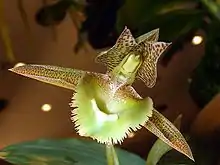Catasetum fimbriatum
Catasetum fimbriatum, the fringed catasetum, is a member of the orchid family of flowering plants and lives in a warm tropical environment. This plant uses a fascinating strategy to spread its pollen to other flowers via insects, primarily bees. When a pollinator lands on male flowers of C. fimbriatum and stimulates them, pollen is planted onto the back of the pollinator. This assures their gametes will be spread to other flowers the bee visits of the same species.[1]
| Catasetum fimbriatum | |
|---|---|
 | |
| Scientific classification | |
| Kingdom: | Plantae |
| Clade: | Tracheophytes |
| Clade: | Angiosperms |
| Clade: | Monocots |
| Order: | Asparagales |
| Family: | Orchidaceae |
| Subfamily: | Epidendroideae |
| Genus: | Catasetum |
| Species: | C. fimbriatum |
| Binomial name | |
| Catasetum fimbriatum (C. Morren) Lindl. (1850) | |
| Synonyms | |
| |
The mechanism behind how male C. fimbriatum ejects its pollen onto bees is still not well understood. However, kinetic studies have been done. When a bee lands on the flower this stimulates the antennae triggering a quick change in membrane potential. This propagates an action potential that results in an increase in turgor pressure. Immediately following an ejection of pollen onto the back of the bee and according to Simon et al.,[2] can sometimes knock the bee off the flower. Indeed, this was probably an evolved adaptation to prevent cross pollination [3]
Darwin's bee-trap experiment analyzed the kinetics and activation of this trigger mechanism of slapping pollen onto the back of bees. Frame by frame analysis was conducted with a V5.0 digital camera that captures images at 1,000 pictures per second.[3] The antennae of the orchid that set off the catapult of pollen was activated using a small wire. Many other experiments have shown evidence of electrical changes in membrane potential in plants such as the carnivorous Venus flytrap using ion-selective micro-electrodes [4] and the Mimosa plant using ion analysis in addition to X-ray fluorescence spectroscopy.[5] Future experiments utilizing these techniques could elucidate a more vivid picture of how this mechanism works on the molecular level.
References
- Braam, Janet (2004). "In Touch: Plant Responses to Mechanical Stimuli". New Phytologist. 165 (2): 373–389. doi:10.1111/j.1469-8137.2004.01263.x.
- Simons, Paul. "An Explosive Start for Plants: Plants Get up to Some Ingenious Tricks and Aerial Acrobatics to Ensure Their Survival". New Scientist.
- Nicholson, Charles C. (2008). "Darwin's Bee-Trap: The Kinetics of Catasetum, a New World Orchid". Plant Signaling & Behavior. 3: 19–23. doi:10.4161/psb.3.1.4980. PMC 2633950. PMID 19516977.
- Hedrich, Rainer (2018). "Venus Flytrap: How an Excitable, Carnivorous Plant Works". Trends in Plant Science. 23 (3): 220–234. doi:10.1016/j.tplants.2017.12.004. PMID 29336976.
- Allen, R. D. (1969). "Mechanism of the Seismonastic Reaction in Mimosa Pudica". Plant Physiology. 44: 1101–1107. doi:10.1104/pp.44.8.1101. PMC 396223. PMID 16657174.